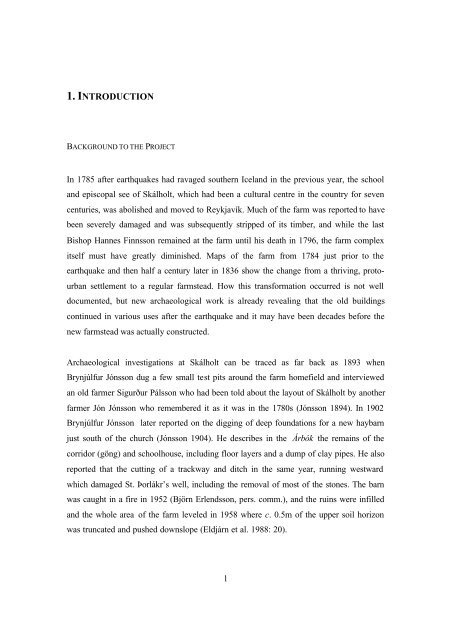Skáholt 2002 - Nabo
Skáholt 2002 - Nabo
Skáholt 2002 - Nabo
Create successful ePaper yourself
Turn your PDF publications into a flip-book with our unique Google optimized e-Paper software.
1. INTRODUCTION<br />
BACKGROUND TO THE PROJECT<br />
In 1785 after earthquakes had ravaged southern Iceland in the previous year, the school<br />
and episcopal see of Skálholt, which had been a cultural centre in the country for seven<br />
centuries, was abolished and moved to Reykjavík. Much of the farm was reported to have<br />
been severely damaged and was subsequently stripped of its timber, and while the last<br />
Bishop Hannes Finnsson remained at the farm until his death in 1796, the farm complex<br />
itself must have greatly diminished. Maps of the farm from 1784 just prior to the<br />
earthquake and then half a century later in 1836 show the change from a thriving, protourban<br />
settlement to a regular farmstead. How this transformation occurred is not well<br />
documented, but new archaeological work is already revealing that the old buildings<br />
continued in various uses after the earthquake and it may have been decades before the<br />
new farmstead was actually constructed.<br />
Archaeological investigations at Skálholt can be traced as far back as 1893 when<br />
Brynjúlfur Jónsson dug a few small test pits around the farm homefield and interviewed<br />
an old farmer Sigurður Pálsson who had been told about the layout of Skálholt by another<br />
farmer Jón Jónsson who remembered it as it was in the 1780s (Jónsson 1894). In 1902<br />
Brynjúlfur Jónsson later reported on the digging of deep foundations for a new haybarn<br />
just south of the church (Jónsson 1904). He describes in the Árbók the remains of the<br />
corridor (göng) and schoolhouse, including floor layers and a dump of clay pipes. He also<br />
reported that the cutting of a trackway and ditch in the same year, running westward<br />
which damaged St. Þorlákr’s well, including the removal of most of the stones. The barn<br />
was caught in a fire in 1952 (Björn Erlendsson, pers. comm.), and the ruins were infilled<br />
and the whole area of the farm leveled in 1958 where c. 0.5m of the upper soil horizon<br />
was truncated and pushed downslope (Eldjárn et al. 1988: 20).<br />
1
















